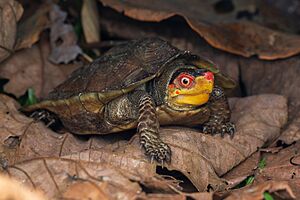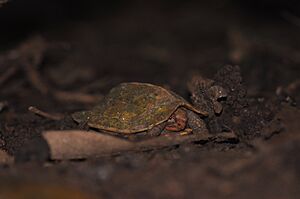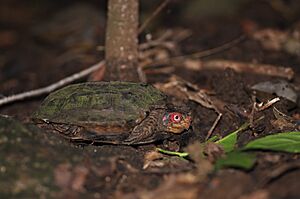Cane turtle facts for kids
Quick facts for kids Cochin forest cane turtle |
|
|---|---|
 |
|
| Conservation status | |
| Scientific classification | |
| Genus: |
Vijayachelys
|
| Species: |
silvatica
|
| Synonyms | |
|
|
The Cochin forest cane turtle (Vijayachelys silvatica) is a very rare turtle found in the Western Ghats of India. People also call it the Kavalai forest turtle or just cane turtle.
Scientists first described this turtle in 1912. They found it near Kavalai in the Cochin State Forests. It lived in thick forests about 1,500 feet (457 meters) above sea level. Only two turtles were found back then. For the next 70 years, no scientist saw this turtle again!
But in 1982, it was rediscovered. Since then, more of these turtles have been found. Scientists have also learned more about how they are related to other animals and how they live.
What is a Cochin Forest Cane Turtle?
The Cochin forest cane turtle belongs to a group of turtles called Geoemydidae. It was once thought to be part of the Geoemyda or Heosemys groups.
However, scientists later found it was very special and different. So, they gave it its own unique group, called a monotypic genus, named Vijayachelys. This name honors a famous Indian herpetologist (a scientist who studies reptiles and amphibians) named Jagannathan Vijaya. She was the one who rediscovered this turtle in 1982 and studied it a lot until she passed away.
What Does It Look Like?
This turtle has a shell that is quite flat. It has a clear ridge, like a small hill, down the middle of its back. It also has a less noticeable ridge on each side. The back edge of its shell is slightly turned up and usually not jagged.
The front part of the shell, near the neck, has a small plate called a scute. The plates on its back are wider at the front than at the back. They are also wider than they are long.
The bottom shell, called the plastron, is quite large. It's almost as big as the opening of the top shell. It connects to the top shell with strong tissues called ligaments. In female turtles, the bones of the shell are not fully joined, which makes it a bit flexible. The plastron has angled sides and open curves at the front and back.
The turtle's head is quite big. It has a blunt snout that is as long as its large eyes. The upper jaw is hooked, and its lower jaw is very long. The skin on the back of its head is covered in medium-sized plates.
Its front legs have large, square or pointed scales. The back legs are shaped like clubs and also have large scales. Its fingers are partly webbed, but its toes only have tiny webs. The tail is short. In males, it gets very thin behind the cloaca (the opening for waste and reproduction). In females, it's just a small stump.
The first turtle found had a dark bronze top shell. Its bottom shell was yellowish with two dark spots on each side. When alive, its jaws and the front top part of its head are bright yellow, with a red spot on its snout. The back of its head and neck are brown. Its legs and tail are black.
The first turtle found had a shell about 12 centimeters (4.7 inches) long. Females are a little bigger than males. But this turtle is quite small and usually doesn't grow longer than about 13 centimeters (5.1 inches).
Where Does It Live and What Does It Eat?
This turtle lives in thick evergreen forests, usually at lower elevations. People who live in the area told scientists that these turtles live in short burrows underground. They don't seem to care much about being near water, unlike some other turtles that love water.

The first turtles kept by scientists only ate plants. However, later studies showed that this turtle is an omnivorous eater. This means it eats both plants and animals, as long as they are small enough.
Why Is This Turtle Special? (Conservation)
The Cochin forest cane turtle is listed as an endangered species by the IUCN (International Union for Conservation of Nature). This means it is at a very high risk of becoming extinct in the wild. It is also listed in CITES Appendix II, which means its trade is controlled to prevent it from becoming more endangered.
You rarely see this turtle sold as a pet. The Kadar tribe people sometimes hunt these turtles for food. Other big dangers to these turtles are forests being cut down and plans for new hydroelectric power projects.
Even though these turtles are found in certain areas, they are still considered a rare species.



